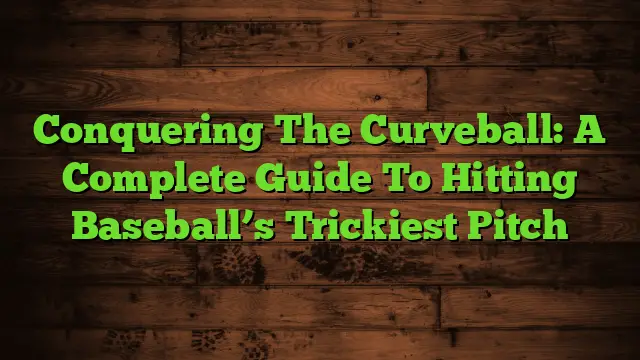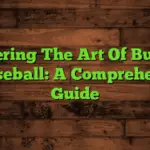It’s the bane of many a batter’s existence: the curveball. That deceptive, dipping, breaking pitch that seems to defy gravity and logic. But fear not, aspiring sluggers! This comprehensive guide will equip you with the knowledge and strategies to conquer this challenging pitch. How to hit a curveball in baseball isn’t just about brute strength; it’s about understanding its physics, adjusting your approach, and honing your technique. We’ll cover everything from recognizing the curveball’s movement to mastering the proper swing mechanics, offering tips and drills to help you consistently make solid contact.
The curveball’s deceptive movement stems from the pitcher’s grip and the Magnus effect. By gripping the ball differently, the pitcher imparts a spin, causing air to move faster on one side of the ball than the other. This
difference in air pressure creates a force that pushes the ball in the opposite direction of the spin. A typical curveball breaks sharply downward and often laterally as well.
Recognizing the Curveball
Visual Cues and Timing
Learning to recognize a curveball early is critical. Look for subtle cues like the pitcher’s grip, arm angle, and the ball’s release point. Curveballs often have a slower arm speed compared to fastballs, and the trajectory often starts higher before breaking sharply down. Developing sharp vision and anticipation is key to successful hitting.
Adjusting Your Stance and Approach
Weight Distribution and Balance
A proper stance is foundational. Maintain a balanced, athletic stance with your weight evenly distributed. This allows for quick adjustments to the ball’s movement. Avoid leaning too far forward or backward, which can hinder your reaction time.
The Mental Game of Hitting Curveballs
Confidence and Patience
Hitting curveballs requires mental fortitude. Don’t be afraid to take a pitch if you don’t feel comfortable with the curveball’s location or your setup. Patience is key. Develop a disciplined approach and trust your swing.
Mastering the Swing Mechanics
Early Recognition and Timing
Your swing needs to adjust to the late movement of the curveball. Focus on recognizing the pitch early and controlling your swing path to make contact where the ball will end up. Resist the urge to swing too early. Waiting slightly longer gives you time to read the curveball’s trajectory.
Utilizing Your Hands and Eyes
Hand-Eye Coordination and Focus
Exceptional hand-eye coordination is crucial. Practice tracking the ball from its release to its intended location, refining your ability to anticipate its break. Maintain focus throughout the entire swing, even if the initial trajectory is deceptive.
The Importance of Bat Control
Maintaining Bat Speed and Control
Don’t swing too hard! Maintaining control over your bat is critical to making consistent contact. The aim is not to overpower the pitch, but to make firm contact using the ball’s momentum. Controlled swings make for better hits.
The Role of Body Movement
Rotating Your Hips and Core
Power generation starts from the ground up. Your hips and core provide significant power and influence the direction of your swing. Rotate your hips and engage your core during the swing to maximize your hit’s power and trajectory.
Practice Drills for Curveball Mastery
Slow-Pitch Drills and Visualizations
Practicing with slower-pitched balls helps you develop your hand-eye coordination and refine your ability to time your swing accurately. Visualization techniques, such as mentally rehearsing successful hits against curveballs, can also enhance performance.
Advanced Techniques for Curveball Hitting
Using the Backside for Power and Adjustments
Advanced hitters often use their back side (the back foot and hip) to add extra power to the swing and adjust to late pitch movement. This is a critical component of adjusting your swing path to the break of the curveball.
Common Mistakes to Avoid When Hitting Curveballs
Swinging Too Early and Overcompensating
Two major pitfalls are swinging too early or overcompensating for the expected break of the pitch. Early swings miss contact or produce weak hits, while overcompensating leads to a poor swing path and inefficient power transfer.
The Role of the Coach or Trainer
Personalized Feedback and Refinements
A good coach or trainer can spot subtle issues in your swing and provide specific feedback to address them. They offer invaluable insights and guidance in honing your technique. They can also create customized practice drills for your individual needs.
Analyzing Your Swing Using Technology
Video Analysis and Swing Metrics
Modern technologies, such as high-speed cameras and swing analyzers, offer data-driven feedback on your swing mechanics. This provides a quantifiable assessment of your performance and areas needing improvement.
Utilizing Game Footage for Improvement
Identifying Patterns and Weaknesses
Review game footage to identify patterns and weaknesses in your approach to curveballs. Analyzing your swings will provide valuable insights and help highlight what you need to change to improve.
Building Confidence and Consistency
Practice, Repetition and Positive Self-Talk
Confidence is developed through consistent practice, repetition, and positive self-talk. Remind yourself that it’s a process, and focus on small improvements over time.
The Importance of Nutrition and Fitness
Physical Conditioning for Optimal Performance
Peak performance in baseball requires proper nutrition and conditioning. A balanced diet and a targeted fitness plan will ensure your body is ready to perform at its best.
Frequently Asked Questions
What is the most important aspect of hitting a curveball?
Timing and patience are arguably the most critical aspects. You need to wait for the ball to get closer to make an accurate swing, so patience is key. Timing means waiting until the last moment to swing for optimal contact.
How can I improve my hand-eye coordination for curveballs?
Practice makes perfect! Use drills like tee work, soft toss, and even playing catch with a smaller ball. Focus on tracking the ball from release to contact, continually refining your ability to anticipate the curve.
What are the best drills for practicing curveball hitting?
Slow-pitch drills are fantastic for focusing on your swing mechanics without the added difficulty of the pitch speed. Using a pitching machine with adjustable speeds and curve characteristics can provide consistent, controlled practice.
How can I tell if I’m swinging too early?
If you frequently miss the ball or make weak contact, you might be swinging too early. Review game footage and look for the timing of your swing relative to the ball’s arrival. A coach’s feedback can also be valuable here.
Can I improve at hitting curveballs without a coach?
Yes, but a coach offers personalized guidance and feedback that greatly accelerates your improvement. You can still improve on your own through self-analysis, video review, and focused practice.
What role does mental preparation play?
Mental preparation is extremely important. Positive self-talk and mental rehearsal of successful hits are highly beneficial. Maintaining composure and confidence is half the battle.
Why do some hitters struggle more than others with curveballs?
Different hitters have different strengths and weaknesses. Some hitters excel at reacting to moving pitches, while others may need more time to develop these skills. Physical attributes, swing mechanics, and mental approach all play a role.
Final Thoughts
Mastering the art of hitting a curveball is a journey that demands dedication, practice, and a keen understanding of the pitch’s mechanics. By focusing on recognizing the curve early, adjusting your stance, and refining your swing, you can significantly increase your success rate. Remember that consistent practice, incorporating drills, and seeking feedback from a coach or utilizing technology to analyze your swing are all essential components of this process. Don’t be discouraged by initial challenges—with patience, perseverance, and the right techniques, you’ll be confidently connecting with curveballs in no time. So, get out there, practice diligently, and watch your batting average soar!





